Anansi Education Auction
About the African Art and Artifacts
Every year, Anansi's founder and director, Kathryn Roe, collects masks, sculpture, and art from Ghana and the surrounding region. A background knowledge of West African art and deep network of relationships in Ghana helps her find older pieces, not produced for the tourist market. Many we may appreciate as 'art' have been created for a practical metaphysical function.
The items below are a selection of what will be featured in this year's auction.
 |
Ashanti Queen MotherThis exquisite carving of a large female figure has many lovely details: the form of the Ashanti stool upon which she sits is the typical form carved for a woman, she holds a fertility doll in her hand to insure that her children are beautiful, and she carries one tied on her back wrapped in fabric in the manner in which children are still seen carried in West Africa. There are many West African stories that tell of the world beginning from an egg and she holds one in her left hand. She has been dressed with a loin cloth and beads. (17”x5”) |
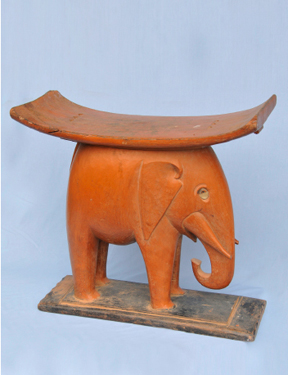 |
Elephant StoolThis Elephant seat or stool is one of many varied forms that can be found in West Africa where the Ashanti people reside. It is very heavy and Kathryn has been told that it is very old one. (21” tall, 10” wide, 22” long) |
 |
Bambara Female and Male Shrine FiguresFigures such as these are brought to the community shrine to participate in public ceremonies. They are considered to illustrate the ideal of physical beauty and character. (15.5” and 14.75”) |
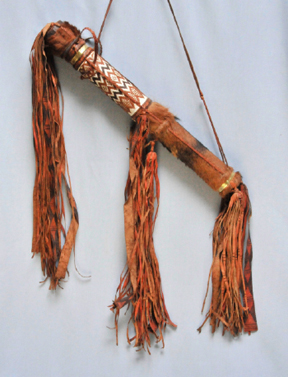 |
Ewe QuiverThis leather quiver, with three small sharp arrows is a reflection of the hunting tradition of many of the peoples of Africa. This quiver derives from the Ewe people that live in Southeastern Ghana and into Southern Togo and Western Benin. A high percentage of the people still practice their traditional animist religions having been less influenced by the influx of Christian and Muslim peoples that have long lived in the same geographic regions. |
 |
Dogon Equestrian StatueThis lovely sculptural representation of a man on horseback is made by an artist of the Dogon people. According to Dogon mythology, horsemen are reminders of the fact that the horse was the first animal present on earth. The Dogon style has evolved into a kind of cubism with ovoid head, squared shoulders, and tapered extremities. This cubist style was present in Africa years before Picasso introduced the form to Western art. The people resided in the cliff dwellings of the Bangalara escarpment. (21.5” tall, 10” wide) |
 |
Red Baule MaskThis red Baule mask is a good example of a Baule entertainment mask. Baule carvers are most concerned with depicting accurate human features in their masks. Through apprenticeship, they learn proper aesthetics of Baule sculpture, which include smooth patina, balanced proportion, clear lines and well rounded asymmetry. The Baule belong to the Akan peoples that inhabit Ghana and Cote d’Ivoire. |
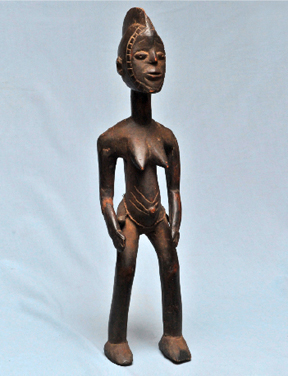 |
Mossi Woman
(25.75” tall, 5.5” wide) |
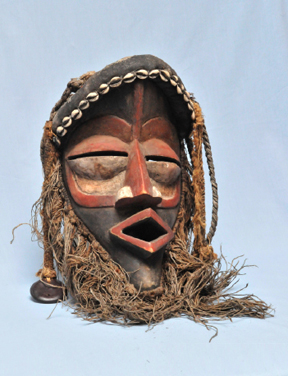 |
We MaskThis mask, with cowrie shells and raffia trim is an expressive and interesting example of the We ethnic group. Most such masks are designed to frighten in masquerades, which hold important regulatory positions within their egalitarian communities. |
 |
Ashanti Mother and ChildThis traditional depiction of a seated woman with child shows the hallmark stool, common scarification indicating tribal affiliation and some fabric and bead details that are lovely. It is difficult to know if she is also representative of the historical figure, Yaa Asantewaa. Yaa Asantewaa led African troops against the British when none of the men were brave enough to do so. Consequently, all know her heroic position within the society. (15”) |
 |
Djembe DrumThis Djembe Drum is a beautiful instrument and was selected for the quality of sound by master drummer, Kofi Klumke, specifically for Anansi. The Adinkra symbol Nkonsonkonson is carved into the side and represents the symbol of unity and human relations, a reminder to contribute to the community and that in unity lies strength. Drumming is inherent to most African cultures and though this drum comes from Ghana, the style comes from the Mali Empire of the 12th century. |
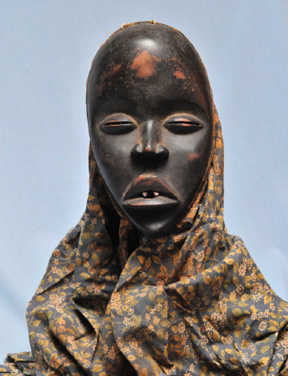 |
Dan MaskThis is a lovely example of a female Dan mask with the high rounded forehead and realistic portrayal of the facial features. The female form is designated by the slit eyes, as opposed to a round eye presentation if the mask were that of a male. The Dan people have lived in Cote D’Ivoire and Liberia since the 8th century BC. |
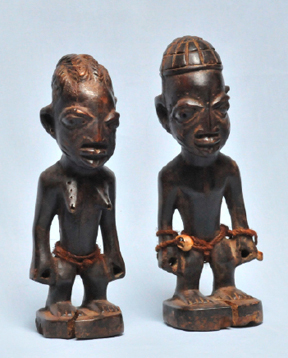 |
Ibeja TwinsThese are two beautiful examples of a Nigerian tradition that dictates that at the death of a twin, a carver makes an image of the dead twin, or both, if both die. Interestingly they are always shown in adult form. These carvings are called Ibeji and used as substitutes for the dead child. They are carried around by their mother, presented with food and brought to family gatherings. (10” and 10.5”) |
 |
Ashanti Fertility DollThe fertility doll as a sculptural form is one of the more familiar to the Western eye. Figures like these were carried by girls and women to promote their fertility, and to ensure the beauty and health of their offspring. The round, flat disc heads, columnar body with outstretch arms and smooth black surface convey the Ashanti ideal of beauty. (12.75”) |
"The objects from Africa that will be presented at the Anansi auction are not tourist decorations. They are real tribal pieces of high museum quality. They are objects that a serious collector of tribal art would want in a private collection. Several of them are old pieces from the early 20th century from the tribes in and around the Ashanti, Yoruba, Senufo, N'gere and Dan tribes and other groups from that area and have the traditional characteristics of the objects used there ritually. Katherine Roe has selected a beautiful set of figures and masks, large and small, for the auction and serious collectors of tribal arts should attend."
Dr. Thomas Schlotterback, PhD University of Iowa, History of Art, Professor Emeritus Western Washington University. 1965 to 1993. Professor, Art History including the History of Tribal Arts, Chair of Art department 1973 to 1983.
